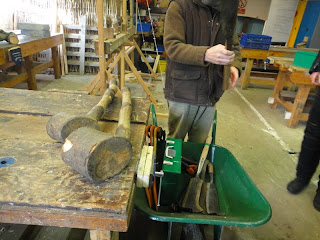Today was a wonderful opportunity to learn more about horticulture and the softer side of landscaping and maintenance. Ellen Sivell, Sophie Guinness and Brian Rodger were fantastic at explaining the various methods involved in each situation.
Our room where we learnt how to sow seeds. First over fill the tray with soil then tap it down three times to give the soil compaction. Too much air inside and then it will sink when you water it. Next, scrape off the excess with a wooden spatula and press down with a wooden board so that you have a nice even and compact surface. This is to ensure that when you sow the seeds, you will have an even germination. Then you must water it before sowing (if you water after sowing then the seeds may be washed off). Give it a good soak with the watering can nozzle turned upwards to avoid the water hitting the soil too hard, sow the seeds with spaces between them for easier separation later and finally label it with the name and date.
Ellen Sivell holding up an example of grafting.
An example of a plant to avoid buying. The roots have become so entertwined that it will eventually strangle itself and die.
A log cut up in different shapes and sizes to create a variety of habitats for beetles and other insects.
Plant Propagation. This was extremely painful to watch.
Air roots of this tree hanging down.
The venus fly trap! Apparently if you trick it to close without food for it to eat, it will eventually die since the energy it expends snapping shut is usually replenished by the prey it digests.
Brian Rodger showing us the various tools used for maintenance and taught us how to sharpen them.
On our way to continue building the hedgerow.
The far left is cut I made! It was hard work but great fun and interesting to see the almost mathmatical process of creating hedgerows.


















No comments:
Post a Comment